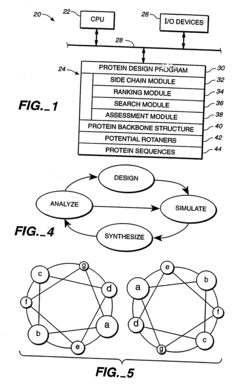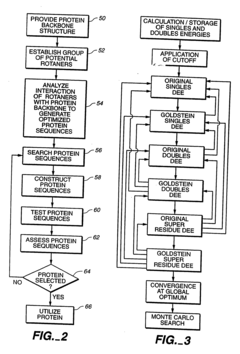Research on Protein Engineering and Rational Design - Eureka
OCT 8, 20244 MIN READ
Generate Your Research Report Instantly with AI Agent
Patsnap Eureka helps you evaluate technical feasibility & market potential.
Protein Engineering Background and Goals
The primary objective is to provide a comprehensive overview of the historical development and current state of protein engineering and rational design technologies. This includes tracing the key milestones and advancements that have shaped this field, as well as identifying the major technical challenges and bottlenecks that currently impede further progress.
Additionally, it is crucial to analyze the geographical distribution of expertise and resources in this domain, highlighting the regions or institutions that have made significant contributions or possess cutting-edge capabilities. By understanding the technological landscape, we can better assess the current limitations and potential avenues for future breakthroughs.
Additionally, it is crucial to analyze the geographical distribution of expertise and resources in this domain, highlighting the regions or institutions that have made significant contributions or possess cutting-edge capabilities. By understanding the technological landscape, we can better assess the current limitations and potential avenues for future breakthroughs.
Market Demand for Protein Engineering
- Protein Engineering Market Overview
Protein engineering has applications across diverse industries like pharmaceuticals, agriculture, food processing, and industrial enzymes. The market demand is driven by the need for improved therapeutics, enhanced crop yields, and efficient industrial processes. - Therapeutic Protein Engineering
The pharmaceutical industry is a major driver, with demand for engineered proteins as biologic drugs, vaccines, and diagnostics. Engineered antibodies, enzymes, and growth factors have significant therapeutic potential. - Agricultural Protein Engineering
Engineered proteins can enhance crop yields, resistance to pests and environmental stresses, and improve nutritional value. This market is driven by the need for sustainable food production. - Industrial Enzyme Engineering
Engineered enzymes find applications in various industrial processes like biofuel production, textile manufacturing, and waste treatment. The demand stems from the need for efficient and eco-friendly processes. - Market Growth Factors
The market is expected to grow due to increasing investments in biotechnology research, rising demand for personalized medicine, and the need for sustainable industrial processes.
Current State and Challenges in Protein Engineering
- Technical Limitations
Protein engineering faces challenges in accurately predicting protein structure and function from sequence data, limiting rational design capabilities. - Computational Power
Computational modeling and simulation of protein folding, dynamics, and interactions require significant computational resources, posing challenges for large-scale protein engineering efforts. - Experimental Validation
Experimental validation of computationally designed proteins is essential but can be time-consuming and resource-intensive, hindering rapid iteration and optimization. - Complexity of Biological Systems
Proteins often function within complex biological systems, making it challenging to account for all relevant interactions and environmental factors in rational design approaches. - Protein Stability and Solubility
Maintaining protein stability and solubility during engineering efforts can be difficult, leading to challenges in producing functional proteins.
Key Players in Protein Engineering Industry
The competitive landscape for "Research on Protein Engineering and Rational Design" is characterized by a mix of academic institutions and companies at various stages of technological maturity. Key players include Suzhou Institute of Biomedical Engineering & Technology, Asymchem Laboratories (Tianjin) Co., Ltd., and Codon Devices, Inc., which are at the forefront of commercial applications. Academic institutions like South China Agricultural University and California Institute of Technology contribute significantly to foundational research. The market is expanding rapidly, driven by advancements in biotechnology and increasing demand for customized protein solutions. The technology is maturing, with companies like Xencor, Inc. and Codexis, Inc. leading in innovative applications.
Xencor, Inc.
Technical Solution: Xencor focuses on protein engineering to create monoclonal antibodies and cytokines with improved properties. Their XmAb technology platform enhances therapeutic proteins by modifying their Fc domains for cancer, autoimmune diseases, and other serious conditions.
Strength: Proven technology with multiple clinical-stage programs. Weakness: High competition in the monoclonal antibody market.
Codexis, Inc.
Technical Solution: Codexis uses protein engineering to develop biocatalysts for pharmaceutical and industrial applications. Their CodeEvolver platform allows for rapid development of customized enzymes that improve chemical processes' efficiency and sustainability.
Strength: Versatile platform with broad applications. Weakness: Dependence on partnerships for commercialization.
Core Innovations in Rational Protein Design
Apparatus and method for automated protein design
PatentInactiveUS20070032961A1
Innovation
- Providing an objective, quantitative design technique for computational protein design and optimization implemented on a computer
- Analyzing the interaction of potential rotamers with the protein backbone structure to generate optimized protein sequences
- Classifying variable residue positions as core, surface or boundary residues and using scoring functions like Van der Waals potential, hydrogen bond potential, atomic solvation, secondary structure propensity and electrostatic scoring functions
Regulatory Landscape for Biotech Innovations
Protein engineering and rational design involve modifying protein structures and functions through computational and experimental approaches. This field aims to create novel proteins with desired properties for various applications, such as biocatalysis, therapeutics, and biomaterials. Key aspects include understanding protein folding, stability, and interactions, as well as developing computational tools for protein design and optimization. Recent advances in structural biology, computational power, and machine learning have accelerated progress in this area, enabling the design of proteins with improved catalytic activity, binding affinity, and stability. However, challenges remain in accurately predicting protein behavior and efficiently exploring the vast sequence space. Continued research is needed to enhance our understanding of protein structure-function relationships and develop more robust design algorithms.
Ethical Considerations in Protein Engineering
Protein engineering and rational design involve modifying protein structures and functions through computational and experimental approaches. This field aims to create novel proteins with desired properties for various applications, such as biocatalysis, therapeutics, and biomaterials. Key aspects include understanding protein folding, stability, and interactions, as well as developing computational tools for protein design and optimization. Recent advances in structural biology, computational power, and machine learning have accelerated progress in this area, enabling the design of proteins with improved catalytic activity, binding affinity, and stability. However, challenges remain in accurately predicting protein behavior and efficiently exploring the vast sequence space. Continued research is needed to enhance our understanding of protein structure-function relationships and develop more robust design algorithms.
Unlock deeper insights with Patsnap Eureka Quick Research — get a full tech report to explore trends and direct your research. Try now!
Generate Your Research Report Instantly with AI Agent
Supercharge your innovation with Patsnap Eureka AI Agent Platform!



